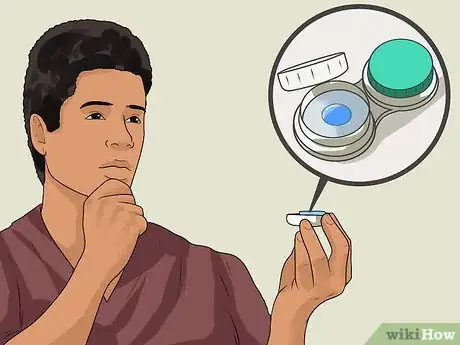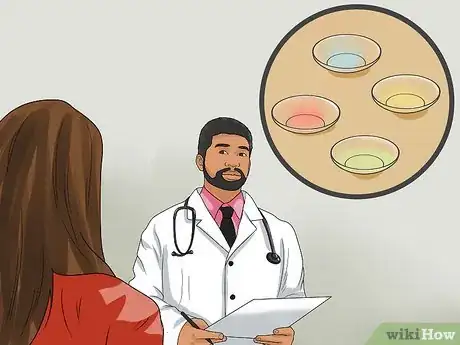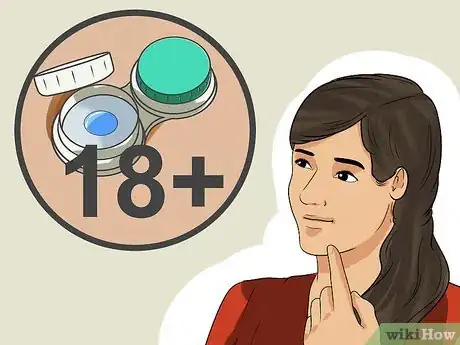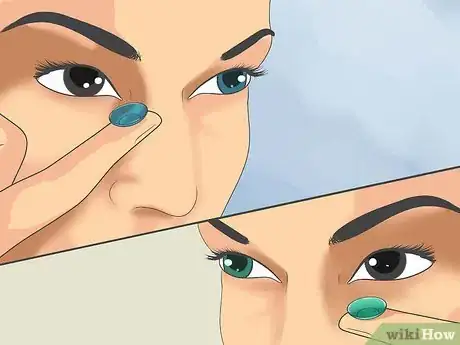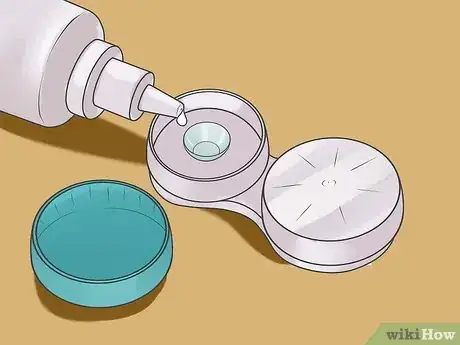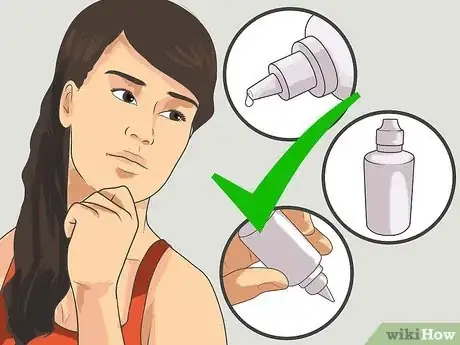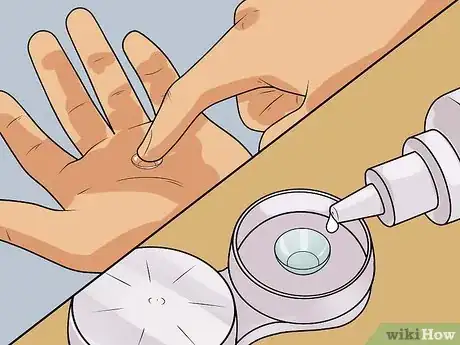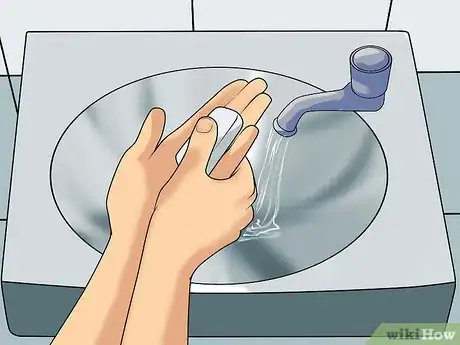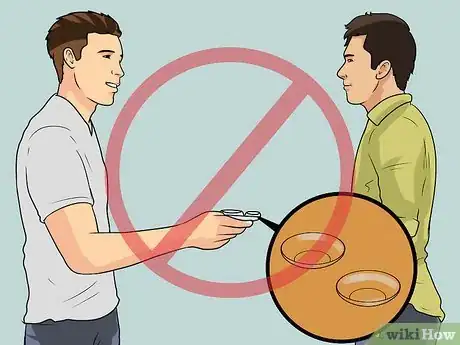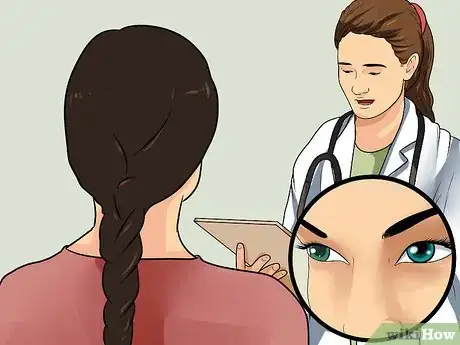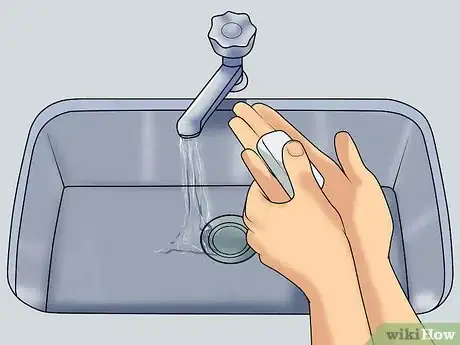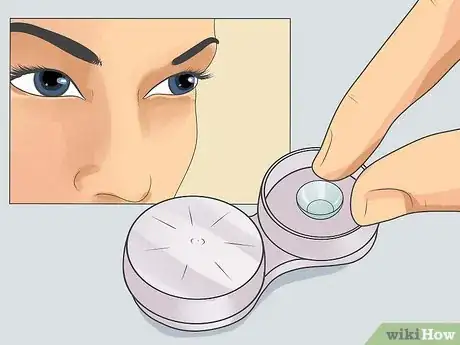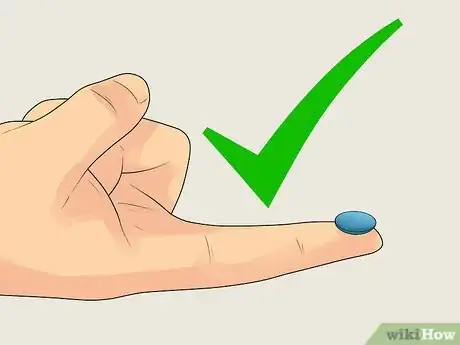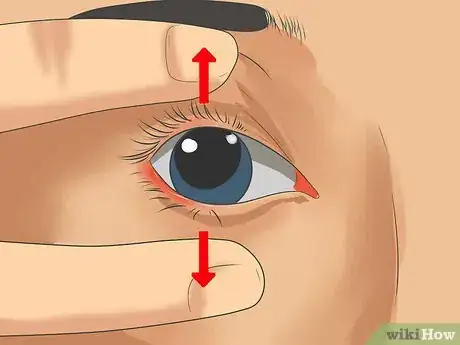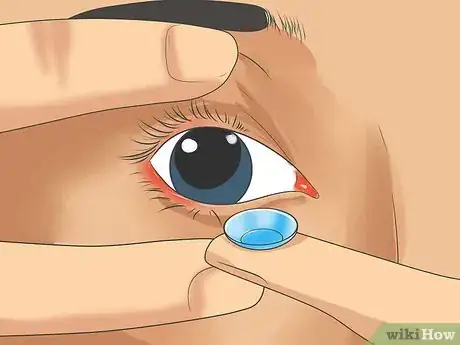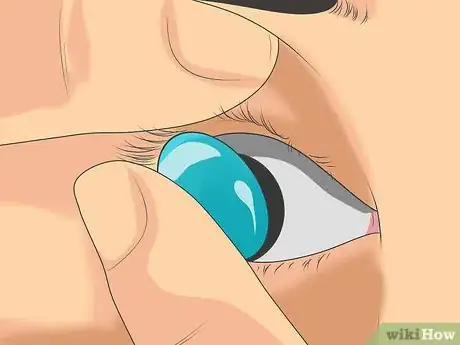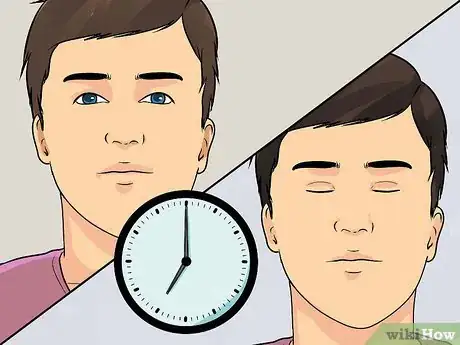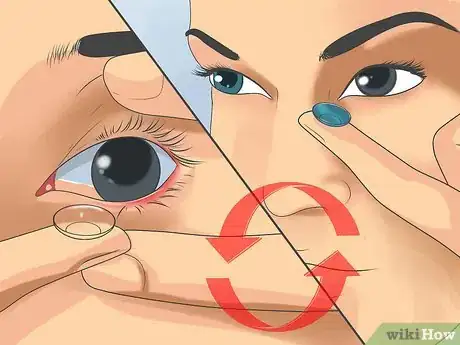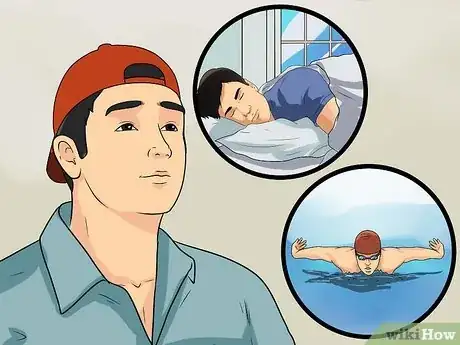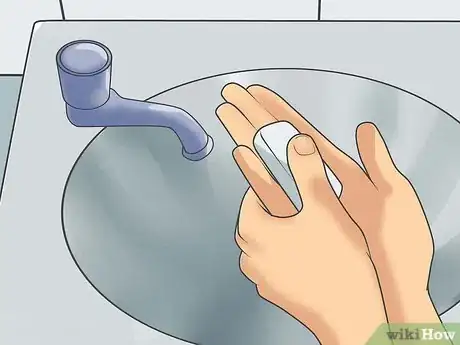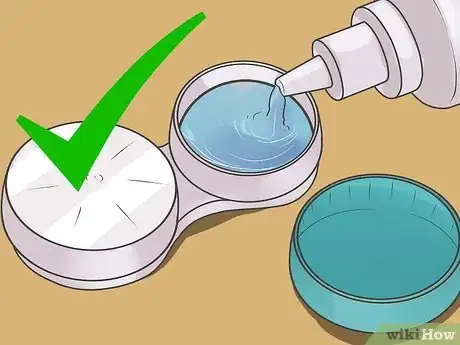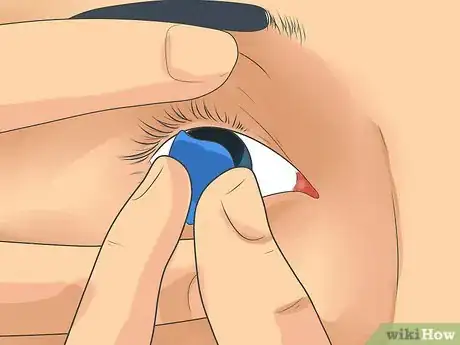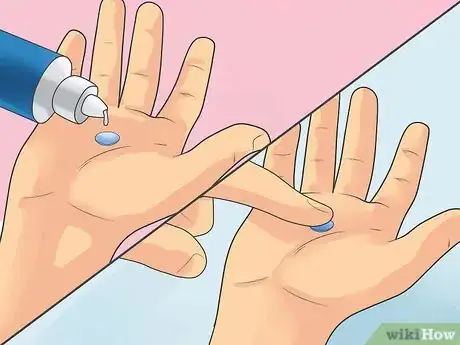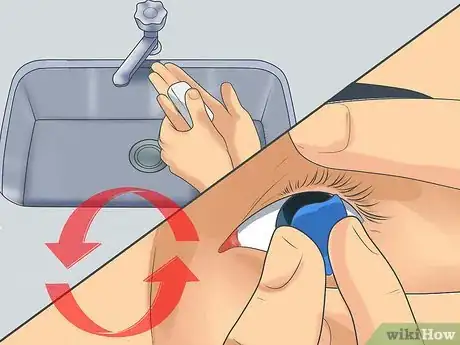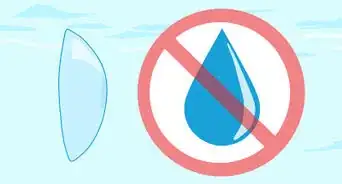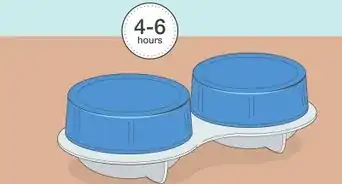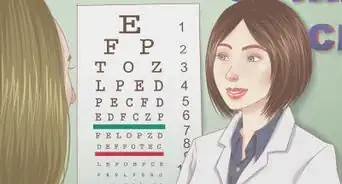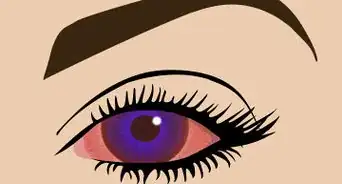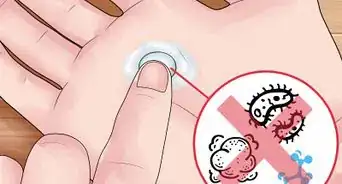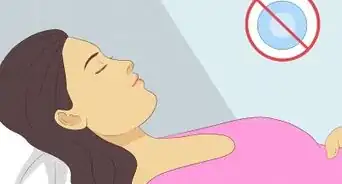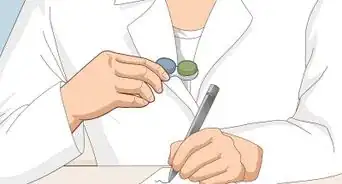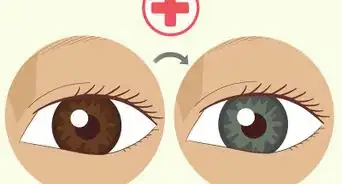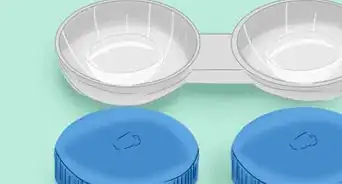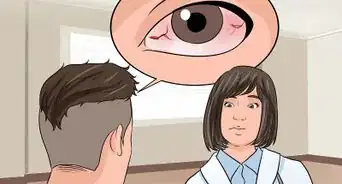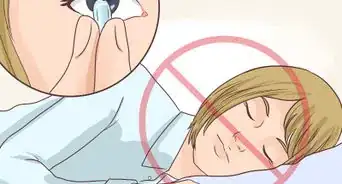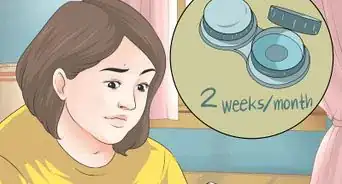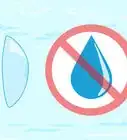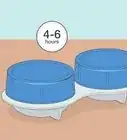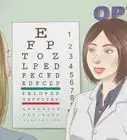This article was medically reviewed by Shaune Wallace, OD. Dr. Wallace is an Optometrist in Nevada with over 14 years of optometry experience. He received his OD from the Southern California College of Optometry in 2006 and is a member of the American Optometric Association.
There are 14 references cited in this article, which can be found at the bottom of the page.
wikiHow marks an article as reader-approved once it receives enough positive feedback. In this case, several readers have written to tell us that this article was helpful to them, earning it our reader-approved status.
This article has been viewed 51,296 times.
Contact lenses can be a daunting endeavor, particularly if you're uncomfortable with touching your eyes. With a little bit of knowledge and some practice, however, you'll be using your contacts like a pro. Be sure to listen to your optometrist, but don't be afraid to experiment until you find a system that works for you!
Steps
Choosing Contact Lenses
-
1Choose the right contact lenses. Your optometrist may offer you various options depending on your particular eyes and needs. Understand what you want from your contacts.
- Length of use: Some contacts are intended to be worn just for one day, then thrown out. Others are designed to be reused for an entire year. In between, there are contacts which are worn monthly and bi-weekly.
- Softer contacts, which are worn for shorter periods of time, are generally more comfortable and healthier for your eyes, but more expensive. Harder contacts may be convenient in the sense that they need not be removed so often — but they are also more rigid, and they may be more difficult to adjust to than the softer varieties.
- Daily wear contacts must be removed every night before you go to bed. Extended wear contacts can be worn when you sleep. Several extended wear lenses are FDA-approved for seven days of continuous use, and certain brands of silicone hydrogel AW lenses are approved for 30 days of continuous use.[1]
-
2Don't be afraid to experiment. Most eye doctors will give you a few options, and most will give you the chance to test out a particular brand or prescription before you commit to a large investment.
- Try different brands. Some brands of contacts are thinner and more porous than others and have smoother edges, making for better comfort; however, they are typically more expensive. A good eye doctor will have you test-drive a brand for a week to make sure they are comfortable.
- If you're unsure about what you want, ask your optometrist for a trial package that includes just one or two pairs of contacts. Your optometrist may also allow you to try out several contacts in their office, once it's clear that you're committed to choosing between one type or another.
Advertisement -
3If you're younger than 18, ask about your optician's policy on minors wearing contacts. Some opticians refuse to prescribe contacts until patients reach a certain age — say, 13 — and some advise only part-time wear until you're of age.
- The concern is whether or not the patient is old enough and responsible enough to care for their contact lenses properly, as improper care can have an impact on eye health. A parent or guardian can help determine if a patient is mature enough to properly care for lenses.[2]
- If your optometrist or your legal guardians decide that you aren't yet old enough to wear contact lenses, get a pair of glasses. You can always start wearing contacts a few years down the line, but you may find that you like wearing glasses just fine.
-
4Consider buying colored contact lenses to change your eye color. You can buy colored lenses with or without a prescription; however, it is not recommended to get colored or novelty contacts over-the-counter or without a prescription (this is actually illegal). Contacts are considered medical devices and a poor fit could cause serious damage to your eyes.[3]
- You can choose a common eye color that's different from your own — say, blue, brown, hazel, green — or you can choose more outlandish colors: red, purple, white, tie-dye, spirals, and cat-eyes.
- If you're getting a prescription for these, be sure to choose something that you're willing to wear every day. Contacts make for expensive novelty products.
Storing and Caring for Contacts
-
1Properly care for your contact lenses whenever they’re not in use. This basically means two things:
- Always store your contacts in contact lens solution, unless you're wearing disposable lenses. Contact lens solution helps to clean, rinse, and disinfect your lenses.
- Dispose of your contact lenses by the recommended date. Most lenses fall into one of three categories: dispose daily, dispose semi-weekly, or dispose monthly. Check your contact lenses for the recommended disposal date and don't wear them much longer than that.[4] There are even online tools available to help you remember when to replace your lenses.[5]
-
2Make sure that you're using the right solution. Some solutions are made specifically for storing contacts, some solutions are made specifically for cleaning and disinfecting contacts, and some can be used for both. Ideally, you should use a combination of the two.
- Storing solutions tend to be saline-based. They are gentle on the eyes, although they may not clean your contacts as effectively as chemical disinfectant solutions.
- Cleaning and disinfecting solutions are either hydrogen peroxide-based (HPB) or multipurpose. HPB solutions require a number of steps, including using a neutralizer to keep the peroxide from harming your corneas when you put them back in. Multipurpose cleaners are easy to use and can often be used to sore contacts as well.
- If your contact solution is irritating your eyes on a regular basis, switch to a hydrogen peroxide solution.
- Always use the disinfecting solution, eye drops, and enzymatic cleaners that your eye-care professional has recommended. Different types of contacts require different types of solutions. Some eye-care products are not safe for contact lens wearers — particularly chemical-based, non-saline eye drops.
-
3Clean your contacts frequently. Ideally, clean them every day, before and after use.[6]
- Clean each contact by rubbing it gently with your index finger in the palm of your other hand. Most multipurpose solutions don’t have “No Rub” on their labels anymore. Lightly rubbing your contact removes surface buildup.
- Change out the lens solution in your lens case every time that you store your contacts. Reusing solution greatly increases your risk of infection and is not advised.
- Clean your contact lens case every time you use it with either sterile solution or hot tap water. Let it air dry. Replace the contact lens storage case at least every three months.
-
4Make sure that your hands are clean before handling the lenses. Wash your hands with soap and warm water, and dry them thoroughly using a clean towel.
- Remember – any residue from soaps, lotions, or chemicals may stick to your contact lenses and cause irritation, pain, or blurred vision, so soaps without scents or lotions are ideal.
-
5Avoid wearing someone else's contact lenses, especially if they've already been worn.
- If you put something into your eye that's already been in someone else's eye, you risk spreading infections and harmful particles from their eye to yours.[7]
- All prescriptions are different. Your friend may be far-sighted while you are near-sighted; or, if you are both near-sighted, they may be significantly more near-sighted than you, to the point that her prescription actually blurs your vision even worse. Some people require specially-shaped contacts for conditions like astigmatism.
-
6Visit your optometrist annually to check your contact lens prescription. You may need to change your prescription as your eyes age and grow.
- Your eyes change over time. Your vision may deteriorate, and you may develop conditions like astigmatism, in which the eye becomes irregularly-shaped and develops refractive issues at all distances.[8]
- Your optometrist may test your eyes for glaucoma — a deteriorative eye disease that can systematically dim your vision — and other potentially harmful eye conditions. It pays to keep up with your optometrist.
Putting in Contact Lenses
-
1Wash your hands with soap. Rinse thoroughly to get rid of soap residue. Dry your hands with a towel (since paper towels or toilet paper may leave pieces behind) or, if possible, an air dryer.[9]
- Any residue from soaps, lotions, or chemicals may stick to your contact lenses and cause irritation, pain, or blurred vision.
- Contacts stick best to wet surfaces. You may find that if you clean your hands, but leave your fingers slightly wet, the contact will stick to your finger more easily.
-
2Remove one contact from its case. Unless the prescription is the same for both, remember to check whether it’s for your right or left eye.
- Leave the other side of the contact case shut, for now, so that dust and particulate matter don't contaminate the contact solution.
- If you place the wrong contact in the wrong eye, you may not be able to see well, and you may experience pain. If your left- and right-eye prescriptions differ significantly, you'll be able to tell when you put the wrong contact in.
-
3Place the contact on the index finger you’re most comfortable with using. (Handle with care, or you may damage or invert the lens.) Make sure that the contact is sitting hollow-side up on your fingertip with none of the side walls sticking to your skin.
- Make sure to handle the lens on the skin of your finger, not the nail of your fingertip. It might be easier if you put a little bit of solution on your finger where you intend on holding the contact lens.
- If it’s a soft contact lens, make sure that it isn’t inside-out. It sounds obvious, but sometimes it's difficult to tell. The contact should be a perfectly concave cup, sloping up evenly to the rim on all sides. If the slope isn't even, then the lens may be inside-out.
- While it’s still on your finger, inspect lens for rips, tears, or debris. If dust or debris is visible, rinse with lens solution before putting it into your eye.
-
4Pull your skin away from your eye. Use the index finger of your opposite hand to pull your upper eyelid upward; use the middle finger of your dominant hand (i.e. the one with the contact on it) to pull your lower eyelid downward. As you become more experienced, you’ll be able to do this just by pulling down your lower eyelid.
-
5Move the contact towards your eye calmly and steadily. Try not to blink or move jerkily. It may help to look upwards. It's also advised to not focus the eye that you're putting the contact into; this will make it easier to place the lens.
-
6Place the contact on your eye. When first starting out it may be easier to place the lens on the white part of the eye than over the iris. The white of the eye is less sensitive and less prone to cause flinching.
-
7Blink slowly so as to not dislodge the contact. Let go of the skin around your eye and softly close your eye and look all around to center the lens. Take note of any pain or discomfort you may have. If you think that something may be wrong with your contact, remove and fully cleanse it, then try again.
- You may need to keep your eye squeezed shut for several seconds to allow the contact to stabilize. If you can activate your tear ducts, however slightly, the natural lubrication will make the process smoother. Cup your hand underneath your eye in case the contact falls out.
- If the contact falls out of your eye, don't worry — this is very common at first. Clean the lens with solution and keep trying until you get it right.
-
8Repeat the process with the other contact. When finished, pour any contact solution from the case into the sink. This is the best time to rinse the contact lens case and let it air dry with the lid off.[10]
- Try keeping your contacts in for just a few hours at a time at first. Your eyes may dry out quickly until they're used to the lenses. If your eyes begin to hurt, take out the contacts and give your eyes a few hours to rest.
Removing Contact Lenses
-
1Know when to remove your contacts. Don't leave your contacts in for longer than your optometrist recommends. You should remove daily-use soft contacts every evening before you go to sleep. You can wear extended-use contacts for longer: several lenses are FDA-approved for seven days of continuous wear, and at least two brands of silicone hydrogel AW lenses are approved for 30 days of continuous wear.[11]
- Remove contact lenses before swimming or using a hot tub. The chlorine puts you at a higher risk for a blinding infection called Acanthamoeba keratitis.[12]
- If you're just starting to wear contacts, your eyes may not be used to the lenses; they'll dry out more quickly at first, and you may experience some pain. Remove your contacts directly after work or school for the first few days — as soon as you don't need perfect vision — in order to give your eyes time to rest.
- Take out your contact lenses before you remove makeup or face paint in the evening to avoid getting any on the lenses.[13]
-
2Make sure that your hands are clean before you remove your contacts. Wash your hands with soap and warm water, and dry your hands thoroughly with a clean, lint-free towel. Again, you may find that slightly wet hands help the contacts stick better to your fingers; this is especially useful when you're removing contacts from your eyes, particularly when the contact has dried tightly onto your eye.
- Keeping your hands clean will dramatically reduce your risk of infection. If you don't clean your hands, then anything that you touched throughout the day — knowingly or unknowingly — will spread to your eyes.
- It is especially important to avoid touching your contacts after you've made any contact with fecal matter — yours, your pet's, or anyone else's. Exposure to fecal matter can cause a pink eye infection and seriously compromise your optical health.
-
3Fill your case about halfway with solution before you take your contacts out. Make sure you store your contacts in contact solution, not saline solution. Saline solution is not a sterile enough solution for storage.[14]
- Be sure to keep particulate matter — dust, hairs, dirt, and other contaminants — from falling into the solution. Cleanliness is of the essence.
-
4Take out the first lens. Use the middle finger of your dominant hand to pull down the skin of your lower eyelid. At the same time, use the index or middle finger of your non-dominant hand to pull up the skin of your upper eyelid.
- Look upward and carefully slide the contact down, away from your pupil, then pluck it out. Use a gentle touch and be careful not to rip the contact.
- Eventually, with practice, you may be able to pluck the contact out without sliding it down. Don't try this before you're confident with your contacts, as a rough touch may rip or tear the lens.
-
5Clean your contact. Place the contact in the palm of your hand. Drench it in contact solution and gently rub it with a finger, in a spiral, from the center to outer edge.
- Flip the contact over and do the same to the other side.
- Rinse the contact again with solution and place it in its proper (left or right) case. Make sure to always keep the contact for each eye in its own separate case. This is especially important, from a logistical standpoint if you have different prescriptions in each of your eyes. Keeping your contacts separate will also reduce the risk of spreading infections between your eyes.
-
6Repeat the above steps to remove and clean your other contact. Again, be sure to place the contact in the correct side of the case. Leave your contacts in the case for at least a couple of hours and rest your eyes.
- If you have trouble removing your contacts at first: practice, practice, practice! The process will only grow easier the more you do it.
Expert Q&A
-
QuestionIs there such a thing as a long-wear soft contact? If so, what are they called?
 Shaune Wallace, ODDr. Wallace is an Optometrist in Nevada with over 14 years of optometry experience. He received his OD from the Southern California College of Optometry in 2006 and is a member of the American Optometric Association.
Shaune Wallace, ODDr. Wallace is an Optometrist in Nevada with over 14 years of optometry experience. He received his OD from the Southern California College of Optometry in 2006 and is a member of the American Optometric Association.
Doctor of Optometry, Southern California College of Optometry Long-wear contact lenses are also known as extended wear contact lenses. These are lenses that can be worn for an extended period of time without being removed and stored overnight.
Long-wear contact lenses are also known as extended wear contact lenses. These are lenses that can be worn for an extended period of time without being removed and stored overnight. -
QuestionIf you rub your eyes will it cause damage?
 Shaune Wallace, ODDr. Wallace is an Optometrist in Nevada with over 14 years of optometry experience. He received his OD from the Southern California College of Optometry in 2006 and is a member of the American Optometric Association.
Shaune Wallace, ODDr. Wallace is an Optometrist in Nevada with over 14 years of optometry experience. He received his OD from the Southern California College of Optometry in 2006 and is a member of the American Optometric Association.
Doctor of Optometry, Southern California College of Optometry Rubbing your eyes can cause damage in a number of ways. For instance, if your eyes are itchy and you rub them, more histamine is released, making them more itchy instead of bringing relief. If your hands are dirty, this can lead to infection. If there is something in your eye, rubbing can scratch and permanently damage your cornea. Instead of rubbing, try flushing your eye with water.
Rubbing your eyes can cause damage in a number of ways. For instance, if your eyes are itchy and you rub them, more histamine is released, making them more itchy instead of bringing relief. If your hands are dirty, this can lead to infection. If there is something in your eye, rubbing can scratch and permanently damage your cornea. Instead of rubbing, try flushing your eye with water.
Warnings
- Take a break if your eye becomes sore or inflamed.⧼thumbs_response⧽
- Wash your hands. Always, always wash your hands.⧼thumbs_response⧽
- If at any time during wear, if your eye becomes irritated in any way, remove the contact. Consult your optician if you have any concerns.⧼thumbs_response⧽
- Make sure no soap is left on your hands.⧼thumbs_response⧽
- Ensure that there are no tears or imperfections in the contact.⧼thumbs_response⧽
References
- ↑ http://www.airoptix.com/contact-lenses/night-and-day.shtml
- ↑ http://www.allaboutvision.com/contacts/faq/safe-for-kids.htm
- ↑ http://www.fda.gov/ForConsumers/ConsumerUpdates/ucm275069.htm
- ↑ http://www.webmd.com/eye-health/news/20090604/wearing-contact-lenses-past-their-prime
- ↑ http://www.acuvue.com/home-acuminder
- ↑ http://www.geteyesmart.org/eyesmart/glasses-contacts-lasik/contact-lens-care.cfm
- ↑ http://www.webmd.com/eye-health/caring-contact-lens
- ↑ http://www.allaboutvision.com/conditions/astigmatism.htm
- ↑ http://www.bausch.com/your-eye-concerns/wearing-contact-lenses/wearing-and-caring-for-contact-lenses#.VVKWlvlViko
- ↑ https://www.1800contacts.com/connect/articles/how-clean-contact-lens-case
- ↑ http://www.allaboutvision.com/contacts/extended.htm
- ↑ https://en.wikipedia.org/wiki/Acanthamoeba_keratitis
- ↑ http://www.contactlensheaven.com/contactlenses-makeup.html
- ↑ http://www.woodhamseye.com/blog/contact-solution-vs-saline-solution-whats-the-difference/
About This Article
To put in contact lenses, start by washing your hands so they're clean. Then, place one of your lenses on your index finger, hollow-side up. Next, use your fingers on your other hand to pull your eyelids away from your eye, and carefully place the contact on your eye. Once the lens is in, let go of your eyelids, close your eyes, and look all around to center the lens. Finally, repeat with the other lens in your other eye. For more tips from our Optometry co-author, like how to take care of your contacts, scroll down!
